Throughout her novels, Jane Austen uses references to carriages as a financial shorthand to signal generational wealth, class divide, status-seeking, and economic dependency. In Pride and Prejudice, this information is often conveyed through characters who are particularly fixated on wealth and social status, such as Mr. Collins, Mrs. Bennet, and Lady Catherine de Bourgh. Sandy Lerner has determined that Austen mentions carriages 394 times throughout her novels. In Pride and Prejudice, the words “carriage” or “carriages” are used 56 times. This number does not include specific references to carriage types. For example, the chaise is mentioned 11 times, a phaeton 4 times, and a coach 12 times. That means, in Pride and Prejudice, there are more than 80 mentions of carriages in one form or another (Austen, ebook). Yet, the abundant references to carriages throughout Austen’s novels, Kirstin Olsen notes, give the modern reader a false impression: “Though carriages seem to be everywhere in Austen’s writings, they were actually rather uncommon in the England she inhabited. They were simply too expensive to keep” (1: 128). The ubiquitous presence of carriages in Austen’s novels suggests that the author uses the carriage as a rhetorical device to communicate implicit meanings more readily understood by contemporary readers of the late eighteenth and early nineteenth centuries.
In the chapter on “Class” in The Cambridge Companion to Jane Austen, Juliet McMaster likens carriage ownership to owning a high-priced car today, adding, “Carriages were status symbols” (123). The same can be said of cars today. Certain brands evoke perceptions about the car and its owner. For example, a Ferrari or Lamborghini is not only expensive but can be considered showy and attention-seeking, perhaps eliciting associations with new money. A stodgier-looking Rolls Royce or vintage Bentley may give the perception of old money or generational wealth (see also Lerner). In a car-dependent culture like Southern California, cars transport people to jobs or entertainment. Someone without money, who owns no car, must rely on public transportation or rides from others. Similarly, in Austen’s novels some of the female characters, lacking a covered carriage, are unable to leave their small village or go to town in inclement weather. Understanding the economics of carriage ownership and classifying the characters by the types of vehicles they drive can help twenty-first-century readers break through the ubiquitous feel of carriages to more easily see class divides and their implications in Austen’s writing. The type or number of carriages a person owns thus becomes a powerful rhetorical device to elicit a particular reaction or add dimension to a character or plot line. By understanding the nature and role of carriages in Austen’s time, modern readers can better gauge the heightened emotional significance of certain scenes or storylines and evaluate a character’s motivation. Used as a rhetorical device, the carriage magnifies the drama and highlights the various relationship dynamics, including those between Mr. Bingley and Mr. Darcy and between Elizabeth and Lady Catherine.
Costs and consequences: The types and roles of carriages
To understand the roles of carriages, we first need to look at the economics of carriage ownership during Austen’s time. Christina Lupton estimates an annual income of £800 was needed to operate a carriage (293). According to Sheryl Craig, maintaining a carriage and horses themselves would cost about £400 per year. The Bennets’ yearly income is £2,000. Therefore, the cost of running a carriage was 20 percent of their income. Consequently, Mr. Collins’s bragging that Lady Catherine de Bourgh regularly orders her carriage for him—“‘I should say, one of her ladyship’s carriages, for she has several’” (178)—is a blatant reference to Lady Catherine’s wealth. While an estate and carriages might be passed along through several generations, when one looks at the day-to-day costs of operating a carriage, even the landed classes required a sizable income or accessible money. As with owning a car today, one must look at the total cost of ownership. Automobile ownership might include a car payment, tax and license, registration, gas, tires, maintenance, and repair. Even if the car is paid off, it still costs money to operate and maintain. Likewise, the total cost of carriage ownership included maintaining the horses, stables, coachmen, repairs, and luxury taxes. Lady Catherine’s ability to maintain several carriages underscores her sizeable wealth.
To understand how different types of carriages convey different rhetorical associations, Jennifer S. Ewing’s in-depth descriptions accompanied by contemporary images provide a handy reference for the modern reader. For example, Ewing presents the chaise as an enclosed carriage having two to four horses, four wheels, one postilion driver (who is mounted on a horse, not on the carriage), and room for three passengers on one forward-facing seat. The chaise is lighter than previous traveling coaches and was considered a good choice for long-distance travel. By detailing the types of carriages and listing the characters within Austen’s novels who have used such vehicles, Ewing gives today’s reader an indispensable guide to differentiating the types of carriages at that time and suggests how Austen’s contemporary readers might have quickly gained knowledge about the characters based on the description of their carriage.

Chaise. W. Felton, A Treatise on Carriages, vol. 2 (1796)
The types and roles of carriages become an important aspect of Austen’s novels, offering a roadmap to wealth and social rank. Pride and Prejudice begins with such a carriage reference as the money-obsessed Mrs. Bennet announces that “‘Mrs. Long says that Netherfield is taken by a young man of large fortune from the north of England; that he came down on Monday in a chaise and four to see the place, and was so much delighted with it that he agreed with Mr. Morris immediately’” (3). Austen’s contemporaries would understand certain details from this carriage description alone. First, Bingley arrives in a chaise. The chaise was considered a less stodgy, more practical, and fashionable carriage for travel than a coach (Olsen 136). Without the coachman’s box, the lighter chaise was faster, especially with four horses. As four horses cost more to feed and maintain than two, Mr. Bingley immediately gains attention from the neighbors because of his newer, more fashionable carriage and four horses. The added knowledge that Mr. Bingley is looking for an estate to occupy combines with the carriage reference to reinforce our understanding that Mr. Bingley is newly monied.
Carriage as a rhetorical device: The one percent
Writing about the income levels during the early nineteenth century, David M. Shapard explains that “less than one percent of the population had an income of two thousand a year” (qtd. in Ewing). The Bennets, then, are part of the one percent. Olsen reinforces our understanding of the Bennets’ position by stating that fewer than 1 in 100 people owned a carriage (1: 129). Lerner, moving beyond the car analogy, argues, “When you look at the socioeconomics of carriage ownership, about the same percentage of people today own and fly a private airplane.” While Austen may be writing about the one percent, her novels are able to emphasize class divisions even within this highest level of society. The generous number of carriage references in the novels makes them feel more commonplace than out of reach to today’s reader, but with the added context of carriage knowledge, the modern reader can decipher rhetorical effects lost during the two hundred years since the novel’s first publication. A closer look at a few of the key characters in relationship to the vehicles they use or notice helps demonstrate the rhetorical impact of carriages in Austen’s storylines.
Elizabeth vs. Lady Catherine
Interactions between Lady Catherine and Elizabeth present an avenue for readers to observe the differences in economic status and the motives underlying a character’s actions. Lady Catherine de Bourgh is wealthy, titled, and, as a widow, in charge of her land and money. She shows a keen interest in keeping that wealth within the ranks of high society, as shown by her desire for her daughter to marry Mr. Darcy. Moreover, Lady Catherine likes to control and manipulate others: “Elizabeth found that nothing was beneath this great Lady’s attention, which could furnish her with an occasion of dictating to others” (185). It is no wonder that once Lady Catherine determines that Elizabeth Bennet is a “very genteel, pretty kind of girl,” she sets out to determine her eligibility in the marriage pool. The narrator notes that Lady Catherine “asked her at different times, how many sisters she had, . . . whether any of them were likely to be married, whether they were handsome, where they had been educated, what carriage her father kept, and what had been her mother’s maiden name” (185). In this interrogation, Lady Catherine works through a list of questions that outlines the various barriers used by the upper crust to keep lower gentry from infiltrating the top reaches of society. To assess Elizabeth’s family’s status and income, Lady Catherine works through a number of high-society barriers, including the type of carriage her father keeps.
Another moment when a carriage is significant is when Elizabeth and Maria Lucas are planning to go to London in a post-chaise. While they are not planning to take a public stagecoach, a post-chaise is still not without some danger, as unknown postilions would ride the horses. Elizabeth’s uncle, however, sends a man servant to escort the girls. Lady Catherine doesn’t approve of their plans, saying, “‘I cannot bear the idea of two young women travelling post by themselves. It is highly improper’” (235). Instead, she insists that they should wait and go with her to London in her barouche.
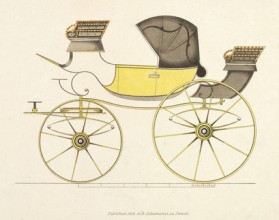 |
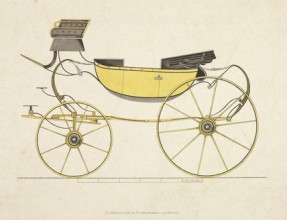 |
| Barouche. Rudolph Ackermann (1816) | |
The barouche had four wheels, with a folding top like a convertible; it seated four people in two facing seats and was driven by a coachman, who sat on the box. It was a stylish choice for good weather and town travel (Ewing). Elizabeth, however, shows her independence in the face of Lady Catherine’s pressure by moving forward with their own travel plans. In this scene of an offer and rejection of a carriage ride, Austen explores the dynamics of power. The carriage is no longer just a form of transportation but a means to entice or oppress, a symbol of power that is resisted. It is a prime example of how Austen uses the carriage to reflect character and drive dramatic action.
The attempted imposition of Lady Catherine’s wealth, power, and dominance intensifies when she arrives at Longbourn to try and stop Elizabeth’s rumored marriage to Mr. Darcy:
One morning . . . their attention was suddenly drawn to the window, by the sound of a carriage; and they perceived a chaise and four driving up the lawn. It was too early in the morning for visitors, and besides, the equipage did not answer to that of any of their neighbours. The horses were post; and neither the carriage, nor the livery of the servant who preceded it, were familiar to them. (389)
A chaise is lighter and faster than an older traveling coach, but most important here is that the horses were post. Post horses could be exchanged with fresh horses at different stage intervals, such as every ten miles, to hasten a trip. Four horses increased the speed, travelling at ten miles per hour rather than the seven to eight miles an hour that two horses could achieve (Ewing). Austen uses these carriage references to dramatize the urgency of Lady Catherine’s agenda. The servant’s livery also highlights social dominance in the power struggle between Lady Catherine and Elizabeth. While the carriage references alone communicate exceptional urgency, the added detail of a socially non-conforming morning visit (“too early for visitors”) underscores Lady Catherine’s need to control and manipulate others.
Social aspiration and status
There are a few instances in Austen’s novels where gigs—new, highly economical carriages—are introduced into the mix. A gig was an affordable alternative form of transportation for those who otherwise could not afford a carriage. The gig was an open two-wheeled two-seater which required only one horse. Due to its cheap construction and lesser stability, however, cartoons from the time often depicted them toppling over and tossing out their passengers. Though today we might view the gig as an economy-class vehicle, Austen uses it as an indication of status and character. Aoife Byrne discusses the gig’s social implications: “Gigs in Austen’s works highlight their owner’s social aspirations, and they illustrate contextual attitudes to those aspirations” (199). Mr. Collins drives a gig.
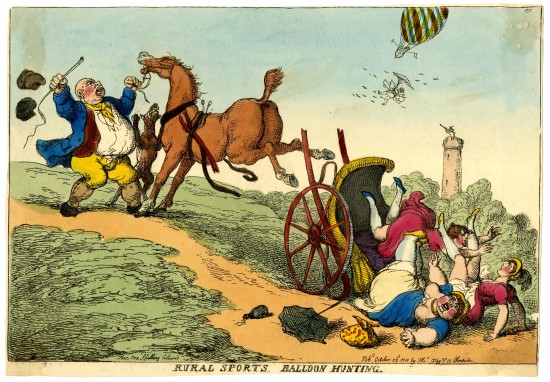
A gig upsets its occupants, Thomas Rowlandson’s Rural Sports. Balloon Hunting (1811).
© Board of Trustees of the British Museum
Throughout the novel, Mr. Collins continually focuses on carriages as status symbols. For example, Charlotte Lucas and Elizabeth “were indebted to Mr. Collins for the knowledge of what carriages went along, and how often especially Miss De Bourgh drove by in her phaeton, which he never failed coming to inform them of, though it happened almost every day” (189). The phaeton had four wheels, with the back wheels being larger than the front, and most commonly pulled by a pair of horses or ponies. The self-driven, open phaeton was “one of the most fashionable vehicles of its day” (Olsen 2: 522). It would make sense that the daughter of Lady Catherine would have a ride that is a bit showy.
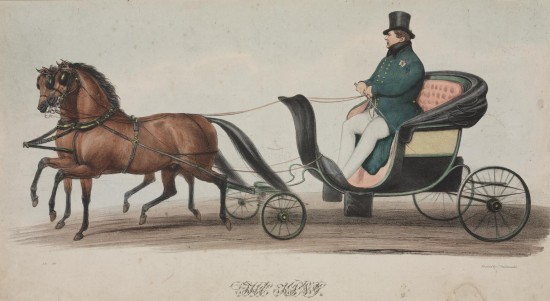
George IV in a pony phaeton (c. 1821–1827).
© Board of Trustees of the Science Museum
A significant aspect of the status attached to vehicles is the number of horses involved. The fact that two, usually matching, horses could be spared for Miss de Bourgh’s phaeton again indicates Lady Catherine’s wealth. In the case of the Bennets, their horses must work the land as well as pull the family carriage, so Jane is sent to Netherfield on horseback, rather than in a carriage, because the Bennets’ horses are conveniently (for Mrs. Bennet) engaged on the farm. The Hursts have a carriage but no horses to draw it (34). The fact that a gig needs only one horse makes it more affordable for Mr. Collins. Elizabeth’s visit reveals that “their other engagements were few; as the style of living in the neighborhood in general, was beyond the Collinses’ reach” (190).
Carriages and Mr. Darcy’s character
Initially, there are few carriages mentioned in connection to Mr. Darcy. Early on, Mrs. Bennet links Mr. Darcy’s behavior at the Mertyon assembly to his reading of carriages as status symbols: “‘he is ate up with pride, and I dare say he had heard somehow that Mrs. Long does not keep a carriage, and had come to the ball in a hack chaise’” (21)—that is, a rented vehicle. Later, Mr. Darcy and Mr. Bingley are seen riding their horses in Meryton (81). Otherwise, we don’t hear much about Mr. Darcy’s carriage until he brings his sister to meet Elizabeth in a curricle (287).
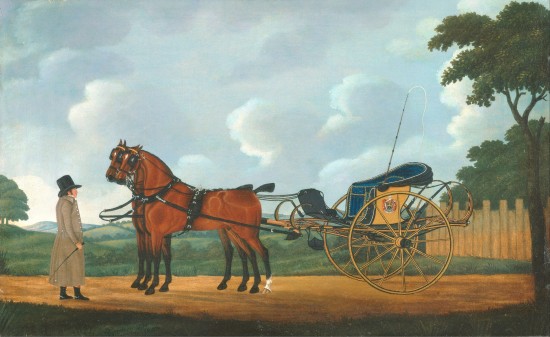
A Gentleman with his Pair of Bays Harnessed to a Curricle by John Cordery (1806).
Courtesy of Yale Center for British Art
The curricle, like the cheaper gig, was also an open, two-wheeled, self-driven two-seater but was made with higher quality materials and sturdier construction. The curricle was driven by two horses, making it a safer and more stable vehicle for long-distance travel, whereas a gig could only withstand local trips. When Mr. Darcy shows up in a curricle, then, his wealth is unquestionable, but the self-driven carriage hints at more humility. He does not show up in a stately carriage, driven by a coachman in livery. He does not play the same game as Lady Catherine. He does not entrench himself behind the lines of high society. For example, “in spite of a great opposition of character” (17), he is close friends with Mr. Bingley, whose family’s fortune was made in trade. Further, Mr. Darcy wants to marry Elizabeth, who will have very little money once her father dies. Unlike Lady Catherine, he is not trying to bar others from the highest echelons of society. His choice of a curricle confirms the point made by Mary and Charlotte that Mr. Darcy is proud of his family and heritage but not necessarily vain (21). Viewing Mr. Darcy’s character through his carriage choice provides a more balanced view of the man—a more objective, even sympathetic glimpse of the single man in possession of a good fortune who must be in want of a wife (1).
![]()
The abundance of carriage references within Austen’s novels demonstrates how Austen craftily uses the carriage as a rhetorical device to shed light on class structure within the gentry and high society. By classifying characters by their carriages, Austen provides keener insights to the reader. For instance, we can glean more about Mr. Darcy’s elusive nature and motivations long before Elizabeth becomes aware of them. Mrs. Gardiner’s teasing suggestion, when she realizes Darcy may be interested in marrying Elizabeth, seems even more playful. In a letter to Elizabeth, Mrs. Gardiner insists that she not be excluded from Pemberley: “‘I shall never be quite happy till I have been all round the park. A low phaeton, with a nice little pair of ponies, would be the very thing’” (360). Even in a showy phaeton, Mrs. Gardiner suggests the more modest low phaeton versus a high one. One can only imagine the even-keeled Mrs. Gardiner, along with Elizabeth, enjoying the ride wholeheartedly but without pretension.
Austen’s carriages reveal nuances of her characterizations and propel her plot lines both for the readers of her own generation as well as the many generations of readers to come. Whether magnifying comedic or dramatic effects, Austen’s use of carriages to amplify her storylines takes the reader of any century on quite the literary ride.
